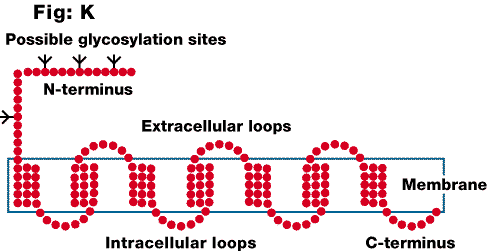Molecular basis of drug action: Receptor superfamilies
Molecular biological techniques have shown that most cell-surface receptors fall into structurally-related types called superfamilies.The main two studies by pharmacologists are G-protein-linked receptors, which share a 7-helical structure and which link to a second messenger through a G-protein, and ligand-gated ion channels, in which the binding of the ligand directly changes an ionic conductance. In addition, some growth-factor receptors are linked to a tyrosine kinase enzyme. Other superfamilies have also been recognised e.g. nuclear receptors for steroids. The number of cloned receptors increases constantly; the lists below were compiled in December 1992, and are not exhaustive.
The 7-transmembrane domain receptor

Fig. K: Schematic diagram of a 7-transmembrane domain receptor in which amino acid residues are represented by filled circles.
This G-protein-linked receptor superfamily is related to bacteriorhodopsin, the first member to be structurally characterised. The common structure consists of 7 alpha-helical units, each spanning the membrane, linked by 3 extracellular and 3 intracellular loops. The third intracellular loop links to the G-protein; often the ligand binding site is found within the space enclosed by the transmembrane loops and/or extracellular domains. The following receptors have been cloned: ACTH, adenosine A1, A2a, A2b and A3, alpha1A-, alpha1B-, alpha1C-, alpha2A-, alpha2B-, alpha2C-, alpha2D-, beta1-, beta2- and beta3-adrenoceptors, angiotensin AT1A and AT1B, arg-vasopressin, bombesin/gastrin releasing peptide, bradykinin B2, calcitonin, cannabinoid receptor, CCKA, CCKB, complement anaphylotoxin C5a, dopamine D1 (A and B), D2, D3, D4 and D5 receptors, endothelin ETA and ETB, 5HT1A, 5HT1B, 5HT1C (now renamed 5HT2C), 5HT1D (alpha and beta), 5HT1E, 5HT2 and 5HT4 receptors, fMLP, FSH, GABAB, six glutamate metabotropic receptors, GnRH, histamine H1 and H2, interleukin IL-8, LH, mas-oncogene product, MSH, muscarinic M1, M2, M3, M4 and M5 receptors, neurokinin NK1, NK2 and NK3, neurotensin, NPY, olfactory receptors, <30>-opioid, oxytocin, PAF, parathormone, prostaglandin EP3, secretin, somatostatin TR1, TR2 and TR3, thrombin, thromboxane, TRH and TSH.
See Probst et al. (1992) for a review.
Tyrosine kinase-linked receptors
These include the insulin receptor and growth factor receptors such
as epidermal growth factor (EGF) and platelet-derived growth factor (PDGF).
See Pazin and Williams (1992).
Ion-channel-linked receptors
This class of receptor are linked to ion-channels, the conductance
of which is modulated by the binding of agonists or antagonists. This superfamily
includes the nicotinic acetylcholine receptor, the GABAA and glycine receptors,
the 5HT3 receptor, the purine P2X receptor and some excitatory amino-acid
receptors. The receptors consist of subunits, each having four transmembrane
domains, which form complexes of varying stoichiometry. Many variant forms
of subunit have been discovered, although the implications of this for
defining receptor subtypes are not yet clear. See Barnard (1992).
References
Barnard, E.A. (1992) Trends Biochem. Sci. 17, 368-374.
Pazin. M.J. and Williams, L.T. Trends Biochem. Sci. 17, 374-378.
Probst, W.C. et al. (1992) DNA and Cell Biol. 11, 1-20.
 |
 |
 |
 |
 |
 |
 |